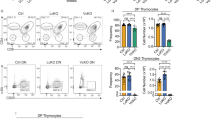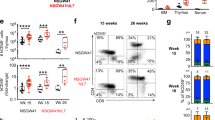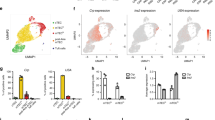Abstract
Adult T-cell leukemia-lymphoma (ATLL) is a group of T-cell malignancies caused by infection with human T-lymphotropic virus type I (HTLV-I). Although the pathogenesis of ATLL remains incompletely understood, the viral regulatory protein Tax is centrally involved in cellular transformation. Here we describe the generation of HTLV-I Tax transgenic mice using the Lck proximal promoter to restrict transgene expression to developing thymocytes. After prolonged latency periods, transgenic mice developed diffuse large-cell lymphomas and leukemia with clinical, pathological and immunological features characteristic of acute ATLL. Transgenic mice were functionally immunocompromised and they developed opportunistic infections. Fulminant disease also developed rapidly in SCID mice after engraftment of lymphomatous cells from transgenic mice. Flow cytometry showed that the cells were CD4− and CD8−, but CD44+, CD25+ and cytoplasmic CD3+. This phenotype is indicative of a thymus-derived pre–T-cell phenotype, and disease development was associated with the constitutive activation of NF-κB. Our model accurately reproduces human disease and will provide a tool for analysis of the molecular events in transformation and for the development of new therapeutics.
This is a preview of subscription content, access via your institution
Access options
Subscribe to this journal
Receive 12 print issues and online access
$209.00 per year
only $17.42 per issue
Buy this article
- Purchase on Springer Link
- Instant access to full article PDF
Prices may be subject to local taxes which are calculated during checkout





Similar content being viewed by others
References
Matsuoka, M. Human T-cell leukemia virus type I and adult T-cell leukemia. Oncogene 22, 5131–5140 (2003).
Takatsuki, K. et al. Clinical diversity in adult T-cell leukemia-lymphoma. Cancer Res. 45, 4644s–4645s (1985).
Hattori, T. et al. Leukaemia of novel gastrointestinal T-lymphocyte population infected with HTLV-I. Lancet 337, 76–77 (1991).
Suzushima, H. et al. Double-negative (CD4- CD8-) T cells from adult T-cell leukemia patients also have poor expression of the T-cell receptor alpha beta/CD3 complex. Blood 81, 1032–1039 (1993).
Kamihira, S. et al. Unusual morphological features of adult T-cell leukemia cells with aberrant immunophenotype. Leuk. Lymphoma 12, 123–130 (1993).
Suzushima, H., Asou, N., Hattori, T. & Takatsuki, K. Adult T-cell leukemia derived from S100 beta positive double-negative (CD4- CD8-) T cells. Leuk. Lymphoma 13, 257–262 (1994).
Shimauchi, T., Hirokawa, Y. & Tokura, Y. Purpuric adult T-cell leukaemia/lymphoma: expansion of unusual CD4/CD8 double-negative malignant T cells expressing CCR4 but bearing the cytotoxic molecule granzyme B. Br. J. Dermatol. 152, 350–352 (2005).
Yamada, Y. et al. Adult T-cell leukemia with atypical surface phenotypes: clinical correlation. J. Clin. Oncol. 3, 782–788 (1985).
Ohata, J. et al. CD4/CD8 double-positive adult T-cell leukemia with preceding cytomegaloviral gastroenterocolitis. Int. J. Hematol. 69, 92–95 (1999).
Ciminale, V. et al. Unusual CD4+CD8+ phenotype in a Greek patient diagnosed with adult T-cell leukemia positive for human T-cell leukemia virus type I (HTLV-I). Leuk. Res. 24, 353–358 (2000).
Uchiyama, T., Yodoi, J., Sagawa, K., Takatsuki, K. & Uchino, H. Adult T-cell leukemia: clinical and hematologic features of 16 cases. Blood 50, 481–492 (1977).
Yoshida, M. Multiple viral strategies of HTLV-1 for dysregulation of cell growth control. Annu. Rev. Immunol. 19, 475–496 (2001).
Jeang, K.T., Giam, C.Z., Majone, F. & Aboud, M. Life, death, and tax: role of HTLV-I oncoprotein in genetic instability and cellular transformation. J. Biol. Chem. 279, 31991–31994 (2004).
Sun, S.C. & Yamaoka, S. Activation of NF-kappaB by HTLV-I and implications for cell transformation. Oncogene 24, 5952–5964 (2005).
Hall, W.W. & Fujisawa, M. Deregulation of cell-signalling pathways in HTLV-I infection. Oncogene 24, 5965–5975 (2005).
Nerenberg, M., Hinrichs, S.H., Reynolds, R.K., Khoury, G. & Jay, G. The tat gene of human T-lymphotropic virus type 1 induces mesenchymal tumors in transgenic mice. Science 237, 1324–1329 (1987).
Hinrichs, S.H., Nerenberg, M., Reynolds, R.K., Khoury, G. & Jay, G. A transgenic mouse model for human neurofibromatosis. Science 237, 1340–1343 (1987).
Green, J.E., Hinrichs, S.H., Vogel, J. & Jay, G. Exocrinopathy resembling Sjogren's syndrome in HTLV-1 tax transgenic mice. Nature 341, 72–74 (1989).
Iwakura, Y. et al. Induction of inflammatory arthropathy resembling rheumatoid arthritis in mice transgenic for HTLV-I. Science 253, 1026–1028 (1991).
Green, J.E., Baird, A.M., Hinrichs, S.H., Klintworth, G.K. & Jay, G. Adrenal medullary tumors and iris proliferation in a transgenic mouse model of neurofibromatosis. Am. J. Pathol. 140, 1401–1410 (1992).
Grossman, W.J. et al. Development of leukemia in mice transgenic for the tax gene of human T-cell leukemia virus type I. Proc. Natl. Acad. Sci. USA 92, 1057–1061 (1995).
Chaffin, K.E. et al. Dissection of thymocyte signaling pathways by in vivo expression of pertussis toxin ADP-ribosyltransferase. EMBO J. 9, 3821–3829 (1990).
Wildin, R.S. et al. Developmental regulation of lck gene expression in T lymphocytes. J. Exp. Med. 173, 383–393 (1991).
Mori, N. et al. Constitutive activation of NF-kappaB in primary adult T-cell leukemia cells. Blood 93, 2360–2368 (1999).
Staal, F.J., Weerkamp, F., Langerak, A.W., Hendriks, R.W. & Clevers, H.C. Transcriptional control of T lymphocyte differentiation. Stem Cells 19, 165–179 (2001).
Rezuke, W.N., Abernathy, E.C. & Tsongalis, G.J. Molecular diagnosis of B- and T-cell lymphomas: fundamental principles and clinical applications. Clin. Chem. 43, 1814–1823 (1997).
Kannagi, M., Ohashi, T., Harashima, N., Hanabuchi, S. & Hasegawa, A. Immunological risks of adult T-cell leukemia at primary HTLV-I infection. Trends Microbiol. 12, 346–352 (2004).
Noguchi, A. et al. Chromosomal mapping and zygosity check of transgenes based on flanking genome sequences determined by genomic walking. Exp. Anim. 53, 103–111 (2004).
Dignam, J.D., Martin, P.L., Shastry, B.S. & Roeder, R.G. Eukaryotic gene transcription with purified components. Methods Enzymol. 101, 582–598 (1983).
Acknowledgements
We thank Y. Sato and E. Tao for their technical assistance. We also thank O. Suzuki, T. Suzuki, M. Moriyama, K. Iwabuchi and Y. Misaki for advice. Y.O. is a Research Fellow of the Japanese Society for the Promotion of Science. These studies were supported by the Japanese Foundation for AIDS Prevention, Core Research for Evolutional Science and Technology (CREST), Ministry of Education and Culture, Japan and the National Virus Reference Laboratory, University College Dublin, Ireland.
Author information
Authors and Affiliations
Corresponding author
Ethics declarations
Competing interests
The authors declare no competing financial interests.
Supplementary information
Supplementary Fig. 1
Transcription factor profiling in SCID splenic lymphomatous cells (SCID-L) nuclear extracts. (PDF 460 kb)
Rights and permissions
About this article
Cite this article
Hasegawa, H., Sawa, H., Lewis, M. et al. Thymus-derived leukemia-lymphoma in mice transgenic for the Tax gene of human T-lymphotropic virus type I. Nat Med 12, 466–472 (2006). https://doi.org/10.1038/nm1389
Received:
Accepted:
Published:
Issue Date:
DOI: https://doi.org/10.1038/nm1389
This article is cited by
-
Primary cells from patients with adult T cell leukemia/lymphoma depend on HTLV-1 Tax expression for NF-κB activation and survival
Blood Cancer Journal (2023)
-
CARD11 mutation and HBZ expression induce lymphoproliferative disease and adult T-cell leukemia/lymphoma
Communications Biology (2022)
-
An acquired phosphatidylinositol 4-phosphate transport initiates T-cell deterioration and leukemogenesis
Nature Communications (2022)
-
Surface protein profiling of prostate-derived extracellular vesicles by mass spectrometry and proximity assays
Communications Biology (2022)
-
Human T-cell lymphotropic virus HBZ and tax mRNA expression are associated with specific clinicopathological features in adult T-cell leukemia/lymphoma
Modern Pathology (2021)



